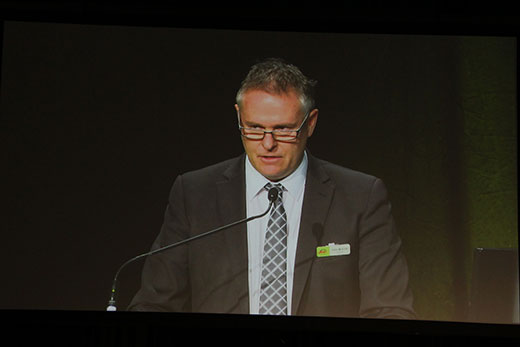Zespri's 16th annual general meeting at the Mount yesterday will go down as one of the shortest and least controversial in the company's history, thanks to increasing grower returns and an optimistic market outlook.
There was no discussion on the AGM's resolutions and, in general, business Zespri chairman Peter McBride had to actively encourage questions from the 350 growers who attended.
Zespri Chief Executive Lain Jager at yesterday's AGM. Photos: Supplied.
In contrast to more troubled times, when the board has faced tough questions, those posed yesterday were mainly around operational matters as opposed to controversy.
And growers have good reason to be satisfied with Zespri, and indeed the whole industry's performance.
Just five years on from the discovery of the devastating vine disease Psa, most growers have returned to profitability and the industry has just harvested their biggest-ever crop, which is now being sold worldwide.
Reflecting on the previous season, Peter says Zespri delivered $1.57 billion of sales in 2014/15 - up 16 per cent despite a sluggish global economy.
'Total fruit and service payments for the season are up to $939 million,” he explains. 'Volumes of NZ kiwifruit sales are up 11 percent to 95.2 million trays this season, and set to grow to over 130 million trays in the next five years.
'As well these headline numbers, Zespri delivered excellent returns to growers and developed sales platforms for the increasing gold volumes in both new and existing markets.”
Chief Executive Lain Jager says orchard gate return per tray for green kiwifruit is up at $6.01, resulting in the highest-ever average per-hectare returns ($53,884).
'This is largely due largely to sales performance, increasing average yields and a shortage of Chilean kiwifruit in the market,” says Lain
Growers of Zespri gold fruit received an average of $9.80 per tray, which translates to $73,890 per hectare.
Organic green growers have achieved $7.37 per tray, or $43,996 per hectare. The new sweet green has returned $7.08 per tray, but low yields means growers' average is $29,682 per hectare.
Lain says foreign exchange continues to impact grower returns, reducing payments by $58.1 million in 2014/15. However, Zespri's hedging policy offset the strength of the NZ dollar by $103.7 million compared to the spot rate.

Zespri chairman Peter McBride says Zespri delivered $1.57 billion of sales in 2014/15 - up 16 percent despite a sluggish global economy.
Peter says the new variety SunGold (Gold3) has performed very successfully on the orchard, throughout the supply chain and in the market.
'We are continuing to build awareness of this new product with consumers and customers through world class marketing,” he says, 'growing demand ahead of the large volume increases coming on.”
Gold volumes are set to grow from 18.7 million trays in 2014/15 to around 30 million trays in 2015/16 and over 60 million trays by 2019/20.
Volumes of the fruit grown for Zespri in the Northern Hemisphere, to provide consistent year-round supply, are forecast to grow from 2.5 million trays in 2014/15 to around 15 million trays in 2019/20.
Zespri's net profit after tax has doubled from $17.2 million in 2013/14 to $34.6 million in 2014/15.
This reflects an exceptional one-off factor of $19.6 million of unpaid revenue from new cultivar licences from previous years (before taxation and fair value adjustment), which were recognised due to greater certainty around SunGold's performance in a Psa environment.
Excluding this figure, Zespri's normalised profit would have been $21.5 million – a figure which more accurately reflects current volumes and the strong investment being made in the growth to come.
Lain says while Zespri is very positive about the outlook for delivering strong, sustainable returns to growers and shareholders, there are considerable headwinds weighing on future returns including the relative weakness of the Euro and Yen, plus recovery of Chilean volumes.
'We will continue to have seasonal ups and downs,” says Lain, 'but in the end, it is our relative rate of innovation compared to the competition which will define our future.”



0 comments
Leave a Comment
You must be logged in to make a comment.